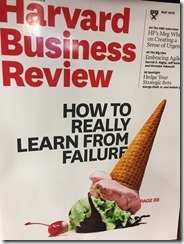Hat tip to Axl Rose. Before I start this motivational rant, let me tell you where I’m coming from. These days I spend most of my OWN/XD time talking to partners and helping them build sustainable, growing businesses. Most of it involves figurative beatings with a dusty copy of E-Myth Revisited because even thought things are going great for some.. it’s just not easy. It requires discipline, it requires mentoring, it requires focus, it requires effort – and some of you old timers are probably dropping your forehead in your palm thinking “These whipper snappers – back in my day software and hardware didn’t even work, what the heck is your excuse?”
So earlier this week I remarked (in one of my Facebook trolls) that MSPs are dying. That is a fact, while the revenues from managed services are going up there are fewer MSPs out there this year than there were last year and there will be less of them next year. My best and fastest growing MSPs are doing so by picking apart their competitors – it’s hard to pick up new business when virtually every vendor, supplier, software manufacturer and so on already provides the monitoring bits while the hardware, software and solution purchases are being rolled up in a bundle that few can compete with for the essentials. The end result: no new blood is coming in and many people are (privately) looking for a way out.
I got into an argument over this fact earlier this week. According to email surveys one dude splices together to justify his employment: things are great – never been better. Yet all of your major MSP vendors are getting bought for pennies on the dollar or getting rolled up into other VC collections of disappointing investments. Few years ago all these companies were going to be giants heading for Wall Street – none have made it – and the excuse is that the environment just isn’t right (if you can’t sell your company during the 7 year bull cycle in which everything doubles that notion doesn’t hold water). Instead for an IPO these companies are heading abroad, heading away from MSPs and into other areas of IT. Conclusion: MSPs are dying.*
And the reality is – many MSPs are doing phenomenally well. If you know how to run a business and know how to focus you’re benefiting at the expense of those that don’t. I love you guys, I don’t want any of you to have to go and get a job. So the rest of this post is about losing your illusion of missing out (#fomo – fear of missing out) and giving you some fool proof steps on how to focus on what works. Fair warning: I am not an MSP coach, I am not a best selling author, I am not a thought leader, I am not a channel chief. So take the following advice with a grain of salt from a humble multimillionaire.
What Should An MSP Do?
Buy and read every book you see published. Ditto with every vendor solution available to fix your problems. Attend every conference you can. Hire coaches cause you don’t know all the answers. Read every blog, spend your day on LinkedIn and Facebook networking. Most importantly, join a peer group where you can be kept accountable by other like minded people that will keep you accountable every step of the way towards your long term goal.
If you need others to keep you accountable then you shouldn’t be in business you low expectation motherfucker. Stop your bitching and get back to work, motivate your people, thrill your clients, try working har..
 I’m sorry, I’m sorry. Totally didn’t mean that. Here, let me introduce you to my friend Joe, who is a much better blogger than I am, who can better explain this #fomo factor of determining how you should prioritize and best spend your time. Here he is in 2009 at MSP Mentor, questioning business leaders whether MSPs will be able to make money in the cloud. The big takeaways are that you need to pick the right vendors and surround the cloud with profitable services only you can deliver.
I’m sorry, I’m sorry. Totally didn’t mean that. Here, let me introduce you to my friend Joe, who is a much better blogger than I am, who can better explain this #fomo factor of determining how you should prioritize and best spend your time. Here he is in 2009 at MSP Mentor, questioning business leaders whether MSPs will be able to make money in the cloud. The big takeaways are that you need to pick the right vendors and surround the cloud with profitable services only you can deliver.
My bad. My bad. I had the wrong picture. No, that’s Joe from Penton Media in 2013 questioning a panel of experts for the insights into how MSPs are best positioning their services around the cloud.
I’m sorry. Ok, this is just embarrassing. Windows 10 update, my files are all over the place. Sorry. No, that’s Joe from Channel e2e last week getting high level conversation on monetization and security in the cloud world.
As you can see, Joe has beaten the damn cloud thing to death over the past decade one panel after another, one blog post after another. He has a fantastic blog I encourage you to follow at www.channele2e.com.
But let me ask you: what has changed in the decade? For $1, anyone want to guess what sort of mastermind secret will come out of the next conference/cloud panel? What sort of life altering motivational speech will finally push you to actually build a multimillion dollar IT business around the cloud? instead of running off to the next event looking for even more motivation and accountability peering like a derranged crackhead.
Here is a tip: aspiring rich IT folks wanted, hard work not included but here is a binder full of crap you won’t follow through on™.
Where does an MSP actually make money?
Since the very origin of the managed services in the early 00’s it’s pioneers always tried to explain that the model wasn’t going to make you rich, it will just give you predictable revenues so you can keep the lights on and make the right investments.
Where does the money come from? Consulting. Projects. Specialized solutions developed in house that hit large distribution.
What do you need to do that? Time. People. Hard work. Motivation. Mentoring and constant investment in staff, training and accountability. Seven day work weeks. Sixty hour weeks. Skipping long vacations for years and only stringing a few days off together when possible. Persistency. Consistency. Long term strategic implementation and monitoring of your plans. You know, difficult shit. The kind of shit that doesn’t sit in a panel because everyone in the audience would cry because that’s what they are trying to get away from and that’s what’s waiting for them upstairs at the hotel room. The sort of stuff that nobody writes books about, the sort of a thing your coach failed at and became an unemployed consultant, the kind of thing they don’t hand out shiny awards for.
Hard work. And since you’re not going to find it in panel, book, conference, this blog post or anywhere else but down in your own self determination.. what’s the threat, what’s the fear?
Threats
I’ll make this quick.
Everyone and everything is an adversary to your success in business. But you know that already otherwise you’d have a job instead of a business. You have to work hard. Threat there is that you’ll miss out on other stuff. But eventually you’ll have employees and now not only will you have to work hard but you’ll have to work even harder trying to mentor and motivate them to do their best job for your clients because nobody will ever love their money like you do until they see how it happens. So you’ll work even harder till you’re so successful you keep on finding out new ways in which you can get taxed. Nirvana. But yeah, it’s not a pretty road up to the top of the mountain.
So what is the actual threat that you need to be worried about?
Is it that you’re working with the wrong vendors, or that you’re not working with them right, or that you just don’t have the right tools? No.
Is it that you’re not staying on top of the industry developments? No. You can get all of Joe 2007-today for free every day for free on your smartphone after the morning post-coffee bathroom break.
Is it that you’re not connected to the right people, not in the thought leadership, not recognized as a maverick and not member of the right crowd? No. Your clients have never heard of these circlejerks.
The only threat you have to fear as an MSP is the threat you pose to yourself by not focusing on managing and growing your business.
Read that a few more times until it sinks in. Then print it out, tape it to your wall and slam your head against it hard whenever you think about distracting yourself from what you actually started your business for. Repeat as often as necessary. May cause concussions and brain damage but in the end it’s still going to be less harmful than spending hundreds of dollars to travel somewhere for a free tshirt and vendor beer. Just email me, I’ll mail you a f’n shirt. Get back to work selling my @#%.
Dying, Consolidating, Diversifying
I sincerely hope this is helpful.
I sincerely cannot be any less angry about this to put it into any more polished words because it sucks seeing your friends have to wrap up their dreams and go get a job because they didn’t feel like working. Don’t be that guy.
Likewise – nobody knows more about how to succeed at your business than you. If your coaches, peers, like minded business owners, etc were such geniuses what in the world would they be wasting their time with your dumb ass for? Think about it. You already know the answer: It’s going to be hard and it’s going to take a lot of work. I know, shitty slogan to put on a trade show backdrop.
But you can take that attitude and the outcome of it to the bank. Dedicate the next 8 months we have left in 2016 to actually doing all the things you halfass right now and see where you’re at in January.
There is no such thing as a fear of missing out. There is just an illusion that someone else, somewhere else, is doing things so much better and smarter than you and they are going to show you how out of the goodness of their heart instead of sipping drinks on some tropical beach. Wake up from the Facebook fantasy, look around at the wasteland of broken MSP IPO vendors, close this f’n window and get back to making your business great.
You’re welcome.







 For the less coherent, more grammatically correct realtime insight, follow me on Twitter at
For the less coherent, more grammatically correct realtime insight, follow me on Twitter at